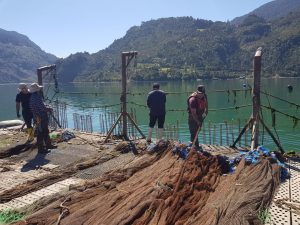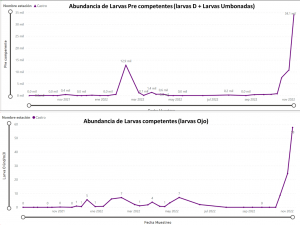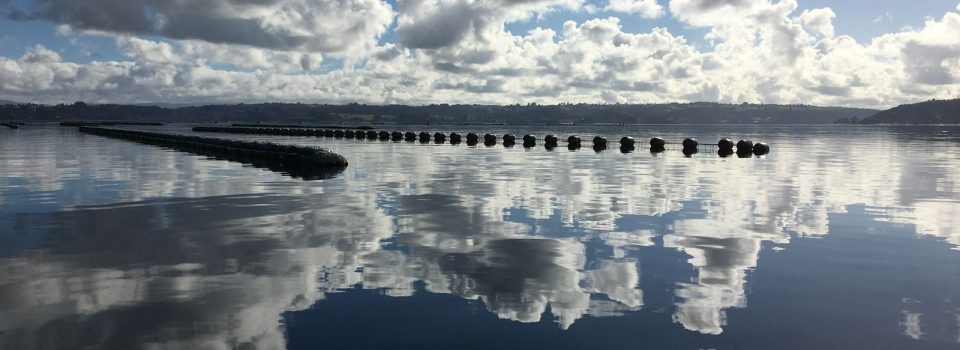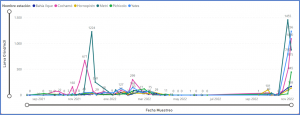IFOP mussel larval monitoring program records a new period of competent mussel larvae in the Los Lagos region
November 29th, 2022 IFOP’s led “Larval Monitoring and Capture of Mutilid Seeds Program ” has identified, until November 17th, 2022, a significant increase in competent mussels larvae abundance (development stage prior to seed capture) which, in territorial terms, have been circumscribed in the areas of fjord and Reloncaví Sound. During the course of this season (August 2022-November 2022), the areas that have registered a greater abundance of competent larvae, above the threshold of 100 larvae /m3, are the Metri sectors (Abu.max.=1455 larvae/m3), Yates (Abu.max.=1236 larvae/m3), Cochamó (Abu.max.=1090 larvae/m3), Pichicolo (Abu.max.=445 larvae/m3), Bahía Ilque (Abu.max .=169 larvae /m3) and Hornopirén (Abu.max=136 larvae /m3; Figure 1). In all these areas, competent larvae abundance increase rate is higher than that recorded during the previous period (August 2021- July 2022; Figure 2).
IFOP’s led “Larval Monitoring and Capture of Mutilid Seeds Program ” has identified, until November 17th, 2022, a significant increase in competent mussels larvae abundance (development stage prior to seed capture) which, in territorial terms, have been circumscribed in the areas of fjord and Reloncaví Sound. During the course of this season (August 2022-November 2022), the areas that have registered a greater abundance of competent larvae, above the threshold of 100 larvae /m3, are the Metri sectors (Abu.max.=1455 larvae/m3), Yates (Abu.max.=1236 larvae/m3), Cochamó (Abu.max.=1090 larvae/m3), Pichicolo (Abu.max.=445 larvae/m3), Bahía Ilque (Abu.max .=169 larvae /m3) and Hornopirén (Abu.max=136 larvae /m3; Figure 1). In all these areas, competent larvae abundance increase rate is higher than that recorded during the previous period (August 2021- July 2022; Figure 2).
In Estero Castro’s case where last year there were practically no competent mussel larvae abundance events which had a uptake of seeds,direct impact this year a positively different situation is evident, since to date registered a maximum of 34,000 pre-competent larvae/m3 and 58 competitive larvae/m3 (Figure 3), which corresponds to 260% and 820% more larvae, respectively, compared to the maximums recorded in the previous season.

Figure 3: Inter-annual comparison between 2021-2022 season and 2022-2023 pre-competent larvae abundance season (D larvae + Umbonate larvae) and Competent (eye larvae) in Estero Castro.
Cristian Segura, IFOP’s researcher, comments that “we are very happy with larval abundance mussels records for this 2022-2023 season, but at the same time we are expecting collection of seeds both in collectors that supply the mussel industry as well as the incorporation of new recruits in the natural banks results . In this sense, a good seed collection season could be expected, but at the same time, progress must be made in collection efficiency in the context of avoiding potential landslides from collectors as much as possible, through productive strategies (eg. thinning or splitting of collectors) and commercial (eg sales of seeds in the smallest possible sizes)”, the researcher pointed out.
Macarena Herrera, IFOP Researcher, pointed out that “we are in constant communication with mussel farmers and Subpesca, who have shown great interest in our results, which can be followed permanently, graphically and interactively, through our visualization platform, which is publicly available at www.ifop.cl (banner: Mussel larva monitoring). Our work team will continue to work hard on larval monitoring plan for mussels and environmental variables at the 12 stations in Los Lagos, 3 stations in Aysén and 1 station in Magallanes, as well as in the evaluation of seed collection in Yates and Estero. Castro,” said the professional.
“Although this is a Fisheries Undersecretariat permanent Program it does not seek to predict catch or to indicate favorable set dates, an effort is made to periodically report the results through the platform where interested parties can consult.” mentioned José Videla Cofré, collaborator of the Larval Monitoring Program led by IFOP.
Press related links:


